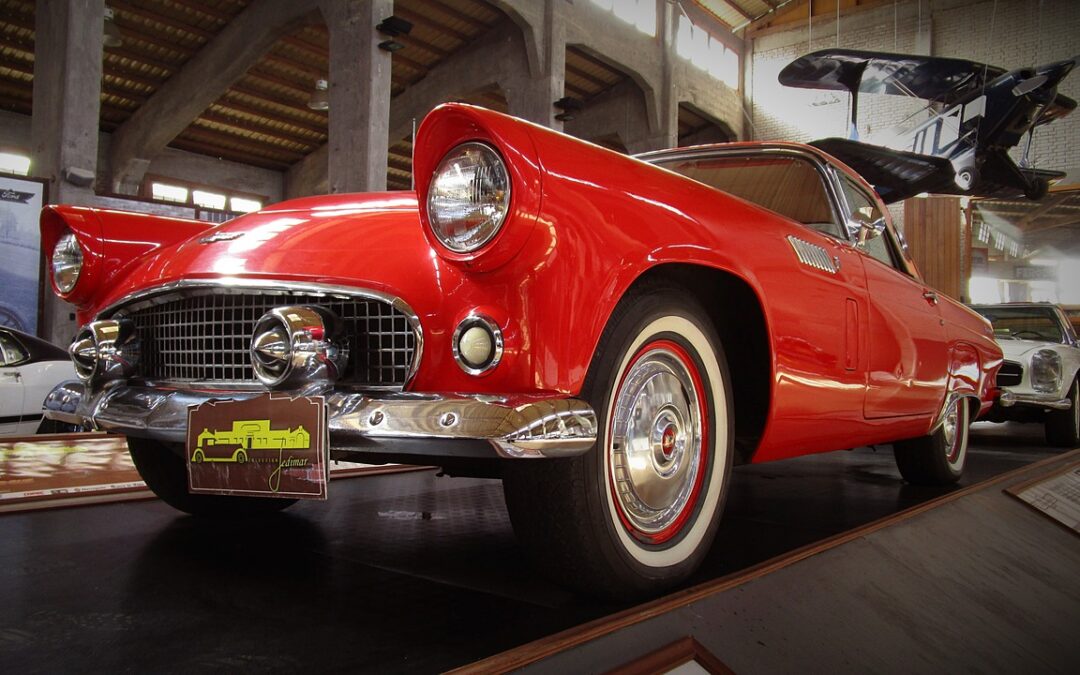When the Ford Thunderbird rolled onto the scene in 1955, it not only captured the imagination of the American public but also set a new standard for luxury and performance in the burgeoning personal luxury car segment. Initially conceptualized as Ford’s answer to the Chevrolet Corvette, the Thunderbird quickly outpaced its rival by emphasizing comfort over sheer sportiness, setting a unique precedent in automotive design and consumer expectation. Over the span of just three years, from 1955 to 1957, the Thunderbird underwent significant evolutionary changes that not only refined its design and features but also solidified its legacy as an icon of American automotive history. This post delves into the nuanced differences between the 1955 and 1957 models, offering enthusiasts and collectors alike a detailed look at their evolution.
Design Philosophy and Aesthetics
1955 Ford Thunderbird: The 1955 Thunderbird, affectionately known as the ‘Baby Bird,’ was Ford’s foray into the sports car market, albeit with a twist focusing on luxury. Its design was a bold departure from typical Ford models, featuring a sleek, low-slung body, a removable fiberglass top, and a distinctive chrome-bordered grille that exuded elegance. The car’s aesthetic was rounded out with subtle tailfins and a clean, uncluttered look that emphasized its upscale intentions.
1957 Ford Thunderbird: By 1957, the Thunderbird had grown both literally and figuratively. The most noticeable change was the introduction of tailfins that were more pronounced than in the 1955 model, reflecting the era’s fascination with jet-inspired design. The front bumper was redesigned to include integrated parking lights, and the grille received a more pronounced treatment that made the car appear wider and more aggressive. These changes were not just cosmetic; they reflected a shift towards a more assertive, confident stance in the market.
Performance and Engineering
1955 Ford Thunderbird: Under the hood, the 1955 Thunderbird was equipped with a 292 Y-block V8 engine, producing 193 horsepower, which was paired with a three-speed manual transmission with an optional overdrive or a Ford-O-Matic automatic transmission. This setup provided a balanced combination of performance and comfort, appealing to drivers looking for a car that offered more than just a pleasant drive.
1957 Ford Thunderbird: The 1957 model upped the ante with more engine options, including a new 312 cubic inch V8 engine that boosted power up to 245 horsepower in its basic form, with options that could take it up to 270 or 285 horsepower with superchargers. This year also saw the introduction of the “E-Code” engine, which featured dual four-barrel carburetors for even greater performance. The enhanced powertrain options in 1957 reflected Ford’s commitment to maintaining the Thunderbird’s position as a leader in the performance segment of luxury cars.
Interior and Features
1955 Ford Thunderbird: The interior of the 1955 model was focused on luxury and comfort, featuring a well-appointed dashboard with a full array of gauges and dials in a single, circular unit that was both functional and aesthetically pleasing. Leather seats and power windows emphasized the car’s upscale market positioning.
1957 Ford Thunderbird: By 1957, the Thunderbird’s interior had become even more luxurious, with available features like a Dial-O-Matic power seat that moved back when the ignition was turned off to allow for easier exit and entry, and an optional “Town & Country” radio. The attention to detail and the inclusion of cutting-edge technology underscored Ford’s commitment to combining luxury with innovation.
Market Impact and Legacy
1955 Ford Thunderbird: The debut model was a hit, selling over 16,000 units, which far exceeded Chevrolet’s Corvette sales. This success was a clear indication that Ford had struck the right balance between sports car appeal and luxury comfort, carving out a niche that would become known as the personal luxury car segment.
1957 Ford Thunderbird: By the end of its first generation in 1957, the Thunderbird had undergone significant refinements and improvements, cementing its status as a luxury icon. The 1957 model year was the most popular, with over 21,000 units sold, highlighting its enduring appeal.
The Ford Thunderbird’s journey from 1955 to 1957 is a fascinating study in automotive evolution, reflecting broader cultural trends and consumer preferences of the 1950s. Each model year brought with it innovations and refinements that not only enhanced the vehicle’s performance and aesthetic but also solidified its legacy as a symbol of American style and luxury. For collectors and enthusiasts, the differences between the 1955 and 1957 Thunderbird models are not just technical but emblematic of an era of exuberance and innovation.

